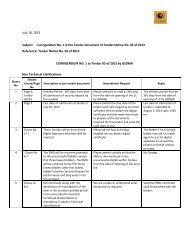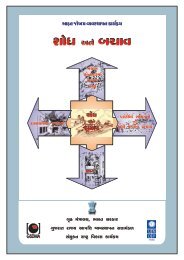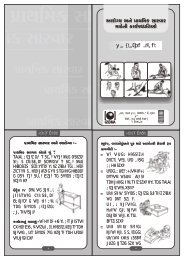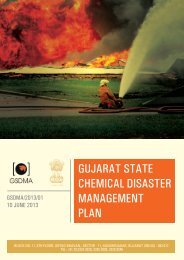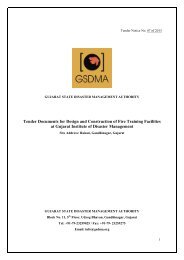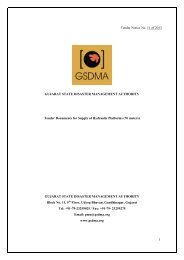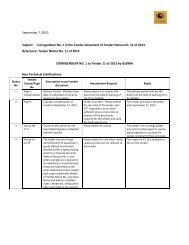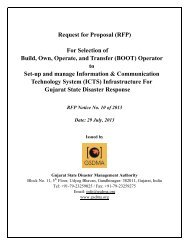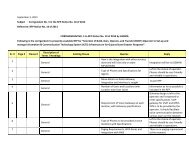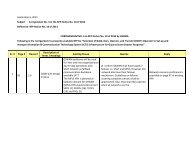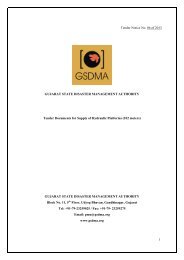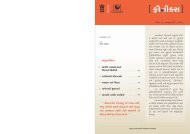Emergency Response Guidebook - Gujarat State Disaster ...
Emergency Response Guidebook - Gujarat State Disaster ...
Emergency Response Guidebook - Gujarat State Disaster ...
You also want an ePaper? Increase the reach of your titles
YUMPU automatically turns print PDFs into web optimized ePapers that Google loves.
GUIDE170Metals (Powders, Dusts, Shavings, Borings,Turnings, or Cuttings, etc.)ERG2012ERG2012Metals (Powders, Dusts, Shavings, Borings,Turnings, or Cuttings, etc.)GUIDE170POTENTIAL HAZARDSFIRE OR EXPLOSION• May react violently or explosively on contact with water.• Some are transported in flammable liquids.• May be ignited by friction, heat, sparks or flames.• Some of these materials will burn with intense heat.• Dusts or fumes may form explosive mixtures in air.• Containers may explode when heated.• May re-ignite after fire is extinguished.HEALTH• Oxides from metallic fires are a severe health hazard.• Inhalation or contact with substance or decomposition products may cause severe injury or death.• Fire may produce irritating, corrosive and/or toxic gases.• Runoff from fire control or dilution water may cause pollution.PUBLIC SAFETY• CALL EMERGENCY RESPONSE Telephone Number on Shipping Paper first. If Shipping Paper notavailable or no answer, refer to appropriate telephone number listed on the inside back cover.• As an immediate precautionary measure, isolate spill or leak area in all directions for at least 50meters (150 feet) for liquids and at least 25 meters (75 feet) for solids.• Stay upwind.• Keep unauthorized personnel away.PROTECTIVE CLOTHING• Wear positive pressure self-contained breathing apparatus (SCBA).• Structural firefighters’ protective clothing will only provide limited protection.EVACUATIONLarge Spill• Consider initial downwind evacuation for at least 50 meters (160 feet).Fire• If tank, rail car or tank truck is involved in a fire, ISOLATE for 800 meters (1/2 mile) in all directions;also, consider initial evacuation for 800 meters (1/2 mile) in all directions.EMERGENCY RESPONSEFIRE• DO NOT USE WATER, FOAM OR CO 2 .• Dousing metallic fires with water will generate hydrogen gas, an extremely dangerous explosionhazard, particularly if fire is in a confined environment (i.e., building, cargo hold, etc.).• Use DRY sand, graphite powder, dry sodium chloride based extinguishers, G-1® or Met-L-X® powder.• Confining and smothering metal fires is preferable rather than applying water.• Move containers from fire area if you can do it without risk.Fire involving Tanks or Car/Trailer Loads• If impossible to extinguish, protect surroundings and allow fire to burn itself out.SPILL OR LEAK• ELIMINATE all ignition sources (no smoking, flares, sparks or flames in immediate area).• Do not touch or walk through spilled material.• Stop leak if you can do it without risk.• Prevent entry into waterways, sewers, basements or confined areas.FIRST AID• Move victim to fresh air.• Call 108 or emergency medical service.• Give artificial respiration if victim is not breathing.• Administer oxygen if breathing is difficult.• Remove and isolate contaminated clothing and shoes.• In case of contact with substance, immediately flush skin or eyes with running water for at least 20minutes.• Keep victim warm and quiet.• Ensure that medical personnel are aware of the material(s) involved and take precautions to protectthemselves.Page 280Page 281



